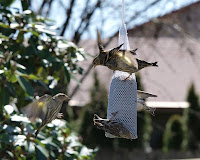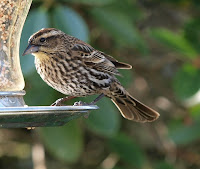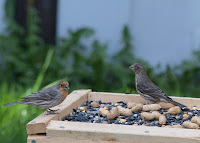This article starts a new feature. Send your queries about Pacific Northwest bird identification or behavior or other topics. I'll do my best to figure out what you saw. I'll do some research. Then I'll write an article to answer your question. If you have a certain question, no doubt others will, too, and appreciate knowing the answer. My goal will be to do one Q & A article each week, answering all the questions I receive that week. I'll just use your first name and city in my answers. If you send photos I will likely use them (perhaps cropping and adjusting exposure for the web) so others can see what you are seeing.
Send questions to me using this link: PNWBB Q & A
To get this started, and serve as a template for future Q & A's, Johnny in Sandy, Oregon agreed to help with the first batch of questions and he even supplied photos. Thanks, Johnny. Here we go...
 "I had the arrival of a group of about 8 or 9 birds that I believe to be Pine Siskins, the day after the first Lesser Goldfinches came to my Njer seed feeder. The Goldfinches have not returned since the new guys took over. And they are constantly bickering and trying to keep everyone else from eating (see photos). Also these guys really put away the grocerys. They eat, go get a drink and eat some more. I don't know how they can fly the eat so much. Are they always like this, or is my flok simply a bunch of hooligans?"
"I had the arrival of a group of about 8 or 9 birds that I believe to be Pine Siskins, the day after the first Lesser Goldfinches came to my Njer seed feeder. The Goldfinches have not returned since the new guys took over. And they are constantly bickering and trying to keep everyone else from eating (see photos). Also these guys really put away the grocerys. They eat, go get a drink and eat some more. I don't know how they can fly the eat so much. Are they always like this, or is my flok simply a bunch of hooligans?"Johnny
Sandy, Oregon
The tiny, goldfinch-sized Pine Siskins are heavily streaked with a strongly notched tail. In flight you can see the yellow wing stripe (Click photo for larger view). They are irruptive in nature, following food sources (seeds and budding trees); they can be unpredictably abundant one year, but perhaps absent or uncommon the next. They breed in the pine forests in mountains in the Pacifc NW, but descend to the lowland regularly in spring for the tree and flower buds. They may occasionally remain through the summer in the lowlands to breed if there is a reliable food source. They are highly social throughout the year, foraging in large flocks, often driving other larger birds from the feeder. In a few weeks they will likely disappear to the mountains. For more information, see Cornell Laboratory of Ornithology's web site on the Pine Siskin Irruption of 2008-09 that is happening primarily in the East. This article has many additional interesting facts about Pine Siskins.
 "I had several new birds in my back yard yesterday. This one is a dead ringer for the female version of the Red Winged Blackbird, (even though it doesn't look at all like a black bird to me) that is on my backyard birds chart. Is It a Blackbird?"
"I had several new birds in my back yard yesterday. This one is a dead ringer for the female version of the Red Winged Blackbird, (even though it doesn't look at all like a black bird to me) that is on my backyard birds chart. Is It a Blackbird?"Johnny
Sandy, Oregon
This is, indeed, a female Red-winged Blackbird. Although it may look like a large sparrow at first, its shape reveals its identity. The long, very pointed bill and flat forehead is common to the blackbirds, cowbirds, meadowlarks, and orioles, which are all in the same family. Sparrows have shorter, conical beaks and most have rather rounded heads. I will unabashedly point you to my Red-winged Blackbird photo album. Compare the head and bill shape of the males with the females. Then go over to my Song Sparrow photo album and compare the bill shape to that of the blackbirds.
 "I had both of these guys in my yard yesterday. I'm pretty sure the yellow one is just a House Finch, but the other bird doesn't look like any I've been able to find. Look closely at the color around the eye."
"I had both of these guys in my yard yesterday. I'm pretty sure the yellow one is just a House Finch, but the other bird doesn't look like any I've been able to find. Look closely at the color around the eye."Johnny
Sandy, Oregon
You are correct, Johnny, these are House Finches. The male is yellowish-orange and within normal range of color variation for this species. See our recent article on House Finches. The other bird is a female. I'm no expert on this, but the female appears to be suffering from the disease, avian conjunctivitis. Birds suffering from this disease display "red, swollen, watery, or crusty eyes; in extreme cases the eyes are so swollen or crusted over that the birds are virtually blind." This disease was first noted in the Eastern population of House Finches in the Washington D.C. area in 1994. It broke out in the West in 2004. For more information see the Cornell Laboratory of Ornithology's web page, House Finch Disease Survey.